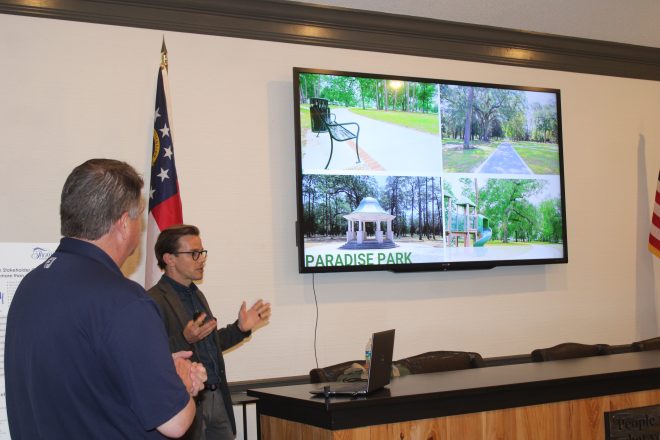Taxed: Weighing the burden of millage rates
Published 11:17 am Saturday, July 8, 2017
VALDOSTA — “Government in general is just a monster. … You can never fill its appetite,” Ricky Gamble said. “The more you give it, the more it will spend.”
Gamble is not a disgruntled taxpayer. He’s the county commission chairman of Suwannee County in North Florida.
Although his words won’t often be repeated by other elected officials, Gamble’s view of government is a common one. Every time a local government introduces a tax hike, residents accuse city and county leaders of wasting money, of padding their own pockets, of overstepping their bounds.
Property taxes often loom large in these political clashes because they are a heavyweight on the tax bill.
When leaders raise the millage rate — the number used to calculate property taxes — they justify the increase by pointing to an unfavorable economy and declining sales tax revenue. They say without a certain level of taxes, they wouldn’t be able to provide the expected level of services to residents.
“Without property taxes, there would have to be significant cuts,” Valdosta Mayor John Gayle said. “Police and fire represent 65 percent of the budget and 70 percent of the personnel in the general fund, which includes property taxes.
“If we want a safe community with a good quality of life, then taxes are necessary.”
Across the SunLight Project coverage area — Valdosta, Dalton, Thomasville, Milledgeville, Tifton and Moultrie, Ga., and Live Oak, Jasper and Mayo, Fla., along with the surrounding counties — common factors drive city/county millage rates and the numbers are pretty similar, with a few outliers on each end of the spectrum.
How do millage rates stack up in the region?
First of all, several millage rates factor into a final property tax bill. In addition to city and county rates, there’s a millage for city and county schools as well as special millages for agencies such as the local industrial authority.
Because cities are seen as an added layer of service, people living in cities have to pay a city millage on top of a county millage, as well as any other extra millages.
One mill equals $1 owed for every $1,000 of a property’s assessed value. Assessed value is how much a tax assessor says a property is worth.
So in simple terms, if someone owned property valued at $1,000 in a county with a millage rate of 5 mills, his or her property tax bill would be $5.
But a home/property owner doesn’t pay taxes on the entire assessed value, at least not in most places. Most governments in Georgia only tax 40 percent of a home or property’s assessed value.
Then, there are certain exemptions, such as for primary residences, that cut down the taxable amount even more.
When it comes to city and county millage rates in the SunLight area, most of the numbers fall in the 8-9 mills range: Baldwin County (9.8 mills), Tifton (9.7), Whitfield County (9.5), Thomas County (9.2 incorporated, 8 unincorporated), Milledgeville (9.1), Suwannee County (9), Live Oak (8.9) and Lowndes County (8.9).
To get an idea of what that means in dollar signs, a Baldwin County (unincorporated) resident with a $100,000 home would pay $394 a year (without exemptions) in property taxes. A Lowndes County resident in the same situation would pay $358 a year.
But remember that’s only how much is owed to the county. The other millage rates, such as the one for schools, bump up the total bill.
On the high end is Tifton at 12.1 mills and Moultrie at 12.8. At the tippy top is Colquitt County with 14.3 mills for unincorporated residents and 16.8 for incorporated. The incorporated rate equates to a $673 tax bill for a $100,000 home if exemptions weren’t on the table.
Valdosta falls just below the pack at 7.95 mills. A $100,000 home there would incur a $318 bill from the city annually. However, the widely used homestead exemption (for homes that are someone’s primary residence) would bring that number down to $270.
Way down the scale is Dalton with a rate of 2.5 mills. That seems like a steal, but Dalton doesn’t tax 40 percent of a home’s assessed value like the other governments. It taxes 100 percent of it, which is why the millage rate is much lower.
Even with the higher tax percentage, Dalton still collects well below the others. To put it in perspective, a person with a $100,000 home in Dalton would pay the city $250 in annual property taxes (excluding exemptions).
In 2009, the Thomasville City Council made it a goal to eliminate property taxes altogether by 2012. It succeeded.
The city pulled off the feat by replacing property tax revenue with profits from Thomasville’s city-owned utilities. The utility companies — electric, water, wastewater, natural gas, solid waste and telecommunications services — are so successful that there are enough profits to fund police and fire protection, street maintenance and other essential governmental services.
“As City of Thomasville utilities are generally at or below the average for the state of Georgia, citizens enjoy the benefits of very competitive utility rates in addition to not paying additional property or fire taxes,” said Steve Sykes, city manager/utilities superintendent.
As evidenced by Thomasville’s non-existent property tax, each community has unique economic conditions, both good and bad, that determine how high property taxes are.
Which towns are facing property tax increases or decreases, and why?
As government revenues fluctuate from year to year, officials are constantly re-evaluating property taxes and deciding if the millage rate should go up, stay the same or go down. The other option is to slash the budget, which means no tax increase but fewer services.
Thomas County Manager Mike Stephenson put it like this: “(Governments) determine the level of services to the public and that determines the amount of revenue necessary to provide those services.”
So essentially, a change in any government’s millage rate hinges on whether the money is there or not, according to officials.
Whitfield County raised the property tax rate by 2.5 mills to 9.561 mills last year. The increase was projected to rake in about $6.25 million. In this case, it was about making up a financial deficit.
Whitfield County faced a $2.9 million deficit in 2016 without a tax increase and a projected $7.1 million deficit this year without the increase. Whitfield officials have long said they run a lean fiscal ship, but some county residents don’t see it that way.
“It seems to me that their first response to any problems is to raise taxes, not cut spending,” Whitfield resident Mary Jones said. “When the private citizen doesn’t have enough money, they have no choice but to cut spending.”
Dalton has cut its millage rate nine years in a row, but it may not be able to continue the streak this year. If revenues are down, the city could see a small increase, from 2.5 to 2.6 mills.
Mayor Dennis Mock said the city might avoid a tax increase but added the city may not be able to continue to cut taxes and provide the services he thinks residents want.
“We’ve really put off some capital spending,” he said. “When I go to the public works department and see the vehicles they are driving and the equipment they are using, I know we can’t keep doing that.”
Dalton resident Sam Woods questioned if perhaps the city’s services were a little too good and therefore too expensive.
“We have great services. I have no doubt about that, maybe the best,” he said. “But do we need the best? We could afford the best back when the carpet industry was booming.
“Can we afford it now? Can we continue to afford it? Maybe instead of the best we can settle for the really good.”
To learn more about how local governments are handling property taxes, pick up the Tuesday, July 11, edition of The Valdosta Daily Times.
The SunLight Project team of journalists who contributed to this report includes Patti Dozier, Thomas Lynn, Charles Oliver, Will Woolever, Alan Mauldin and Eve Guevara, along with the writer, team leader John Stephen.
To contact the team, email sunlightproject@gaflnews.com.





